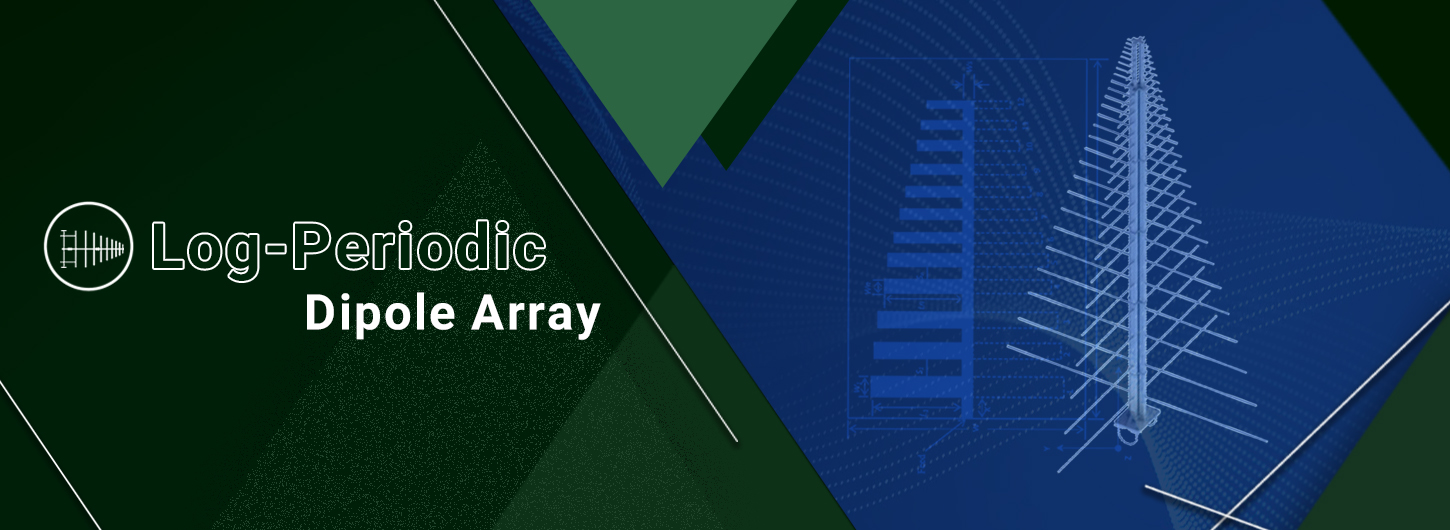
A log-periodic antenna (LP) is a multi-element, directional antenna designed to operate over a wide band of frequencies. It was invented by John Dunlavy in 1952. The log-periodic dipole array, or LPDA, is the most common type of log-periodic antenna. The LPDA consists of a number of half-wave dipole driven elements of gradually increasing length, each consisting of a pair of metal rods. The dipoles are mounted close together in a line, connected in parallel to the feedline with alternating phase. Electrically, it simulates a series of two or three-element Yagi antennas connected together, each set tuned to a different frequency.
A log-periodic antenna is a type of directional antenna that has a characteristic periodic structure. It consists of a series of conductive elements of varying lengths and spacings arranged along a central support structure. The spacing and length of the elements are arranged in such a way that the antenna exhibits a frequency-independent pattern over a wide range of frequencies.
Log-periodic antennas are commonly used in applications where a wide range of frequencies needs to be covered, such as in radio and television broadcasting, radar systems, and wireless communication. They have a frequency range of several octaves, which makes them suitable for use with various communication systems, including VHF, UHF, and microwave frequencies.
The antenna's design makes it very efficient in transmitting and receiving signals over a wide range of frequencies, with minimal loss and distortion. The periodic structure of the antenna ensures that it maintains a constant radiation pattern over a wide range of frequencies, making it ideal for applications that require a directional antenna with a broad bandwidth.
One of the main advantages of log-periodic antennas is their ability to operate over a wide range of frequencies without the need for tuning or adjustments. They also have a high gain, which makes them suitable for use in applications that require long-distance communication or detection. However, their main disadvantage is their complex design, which makes them more challenging to manufacture and assemble than other types of antennas.
LPDA
| NO | Part No. | Frequency (GHz) | Typical Gain (dBi) | Typical VSWR | Connector | Radome | Category | Polarisation | Data Sheet |
|---|---|---|---|---|---|---|---|---|---|
| 1 | LPD-0.03-0.4-SL-NF | 0.03 to 0.4 | -10 to 6 | < 3.5:1 above 0.05GHz | N Female | No | Log Periodic Dipole Array | Single Linear | |
| 2 | LPD-0.03-1-SL-NF | 0.03 to 1 | -10 to 6 | < 3.5:1 above 0.05GHz | N Female | No | Log Periodic Dipole Array | Single Linear | |
| 3 | LPD-0.03-2-SL-NF | 0.03 to 2 | -10 to 6 | < 3.5:1 above 0.05GHz | N Female | No | Log Periodic Dipole Array | Single Linear | |
| 4 | LPD-0.03-3-SL-NF | 0.03 to 3 | -10 to 6 | < 3.5:1 above 0.05GHz | N Female | No | Log Periodic Dipole Array | Single Linear | |
| 5 | LPD-0.04-3-SL-NF | 0.04 to 3 | -10 to 6 | < 3.5:1 above 0.05GHz | N Female | No | Log Periodic Dipole Array | Single Linear | |
| 6 | LPD-0.1-1-SL-NF | 0.1 to 1 | 2 to 8 | < 2:1 | N Female | No | Log Periodic Dipole Array | Single Linear | |
| 7 | LPD-0.1-2-SL-NF | 0.1 to 2 | 2 to 8 | < 2:1 | N Female | No | Log Periodic Dipole Array | Single Linear | |
| 8 | LPD-0.1-3-SL-NF | 0.1 to 3 | 2 to 8 | < 2.2:1 | N Female | No | Log Periodic Dipole Array | Single Linear | |
| 9 | LPD-0.1-4-SL-NF | 0.1 to 4 | 2 to 8 | < 2.5:1 | N Female | No | Log Periodic Dipole Array | Single Linear | |
| 10 | LPD-0.1-6-SL-NF | 0.1 to 6 | 0 to 6 | < 3:1 | N Female | No | Log Periodic Dipole Array | Single Linear | |
| 11 | LPD-0.2-1-SL-NF | 0.2 to 1 | 2 to 7 | < 2:1 | N Female | No | Log Periodic Dipole Array | Single Linear | |
| 12 | LPD-0.2-2-SL-NF | 0.2 to 2 | 2 to 7 | < 2:1 | N Female | No | Log Periodic Dipole Array | Single Linear | |
| 13 | LPD-0.2-3-SL-NF | 0.2 to 3 | 2 to 7 | < 2.2:1 | N Female | No | Log Periodic Dipole Array | Single Linear | |
| 14 | LPD-0-2-4-SL-NF | 0.2 to 4 | 2 to 7 | < 2.5:1 | N Female | No | Log Periodic Dipole Array | Single Linear | |
| 15 | LPD-0.2-6-SL-NF | 0.2 to 6 | 0 to 7 | < 3:1 | N Female | No | Log Periodic Dipole Array | Single Linear | |
| 16 | LPD-0.5-2-SL-NF | 0.5 to 2 | 4 to 8 | < 2:1 | N Female | No | Log Periodic Dipole Array | Single Linear | |
| 17 | LPD-0.5-3-SL-NF | 0.5 to 3 | 4 to 8 | < 2.2:1 | N Female | No | Log Periodic Dipole Array | Single Linear | |
| 18 | LPD-0.5-4-SL-NF | 0.5 to 4 | 3 to 8 | < 2.5:1 | N Female | No | Log Periodic Dipole Array | Single Linear | |
| 19 | LPD-0.5-6-SL-NF | 0.5 to 6 | 2 to 8 | < 3:1 | N Female | No | Log Periodic Dipole Array | Single Linear | |
| 20 | LPD-0.5-8-SL-NF | 0.5 to 8 | 2 to 8 | < 2.5:1 | N Female | No | Log Periodic Dipole Array | Single Linear | |
| 21 | LPD-1-3-SL-NF | 1 to 3 | 4 to 8 | < 2.5:1 | N Female | No | Log Periodic Dipole Array | Single Linear | |
| 22 | LPD-1-6-SL-NF | 1 to 6 | 4 to 8 | < 2.5:1 | N Female | No | Log Periodic Dipole Array | Single Linear | |
| 23 | LPD-1-8-SL-NF | 1 to 8 | 2 to 8 | < 2.5:1 | N Female | No | Log Periodic Dipole Array | Single Linear | |
| 24 | LPD-2-8-SL-NF | 2 to 8 | 4 to 9 | < 2.5:1 | N Female | No | Log Periodic Dipole Array | Single Linear | |
| 25 | LPD-0.03-1-DL-NF | 0.03 to 0.4 | -10 to 6 | < 3.5:1 above 0.05GHz | 2 x N Female | No | Log Periodic Dipole Array | Dual Linear | |
| 26 | LPD-0.03-1-DL-NF | 0.03 to 1 | -10 to 6 | < 3.5:1 above 0.05GHz | 2 x N Female | No | Log Periodic Dipole Array | Dual Linear | |
| 27 | LPD-0-03-2-DL-NF | 0.03 to 2 | -10 to 6 | < 3.5:1 above 0.05GHz | 2 x N Female | No | Log Periodic Dipole Array | Dual Linear | |
| 28 | LPD-0.03-3-DL-NF | 0.03 to 3 | -10 to 6 | < 3.5:1 above 0.05GHz | 2 x N Female | No | Log Periodic Dipole Array | Dual Linear | |
| 29 | LPD-0.04-3-DL-NF | 0.04 to 3 | -10 to 6 | < 3.5:1 above 0.05GHz | 2 x N Female | No | Log Periodic Dipole Array | Dual Linear | |
| 30 | LPD-0.1-1-DL-NF | 0.1 to 1 | 0 to 8 | < 2:1 | 2 x N Female | No | Log Periodic Dipole Array | Dual Linear | |
| 31 | LPD-0.1-2-DL-NF | 0.1 to 2 | 0 to 8 | < 2:1 | 2 x N Female | No | Log Periodic Dipole Array | Dual Linear | |
| 32 | LPD-0.1-3-DL-NF | 0.1 to 3 | 0 to 8 | < 2.2:1 | 2 x N Female | No | Log Periodic Dipole Array | Dual Linear | |
| 33 | LPD-0.1-4-DL-NF | 0.1 to 4 | 0 to 8 | < 2.5:1 | 2 x N Female | No | Log Periodic Dipole Array | Dual Linear | |
| 35 | LPD-0.2-1-DL-NF | 0.2 to 1 | 1 to 7 | < 2:1 | 2 x N Female | No | Log Periodic Dipole Array | Dual Linear | |
| 36 | LPD-0.2-2-DL-NF | 0.2 to 2 | 1 to 7 | < 2:1 | 2 x N Female | No | Log Periodic Dipole Array | Dual Linear | |
| 37 | LPD-0.2-3-DL-NF | 0.2 to 3 | 1 to 7 | < 2.2:1 | 2 x N Female | No | Log Periodic Dipole Array | Dual Linear | |
| 38 | LPD-0.2-4-DL-NF | 0.2 to 4 | 1 to 7 | < 2.5:1 | 2 x N Female | No | Log Periodic Dipole Array | Dual Linear | |
| 40 | LPD-0.5-2-DL-NF | 0.5 to 2 | 2 to 8 | < 2:1 | 2 x N Female | No | Log Periodic Dipole Array | Dual Linear | |
| 41 | LPD-0.5-3-DL-NF | 0.5 to 3 | 2 to 8 | < 2.2:1 | 2 x N Female | No | Log Periodic Dipole Array | Dual Linear | |
| 42 | LPD-0-5-4-DL-NF | 0.5 to 4 | 2 to 8 | < 2.5:1 | 2 x N Female | No | Log Periodic Dipole Array | Dual Linear | |
| 43 | LPD-1-3-DL-NF | 1 to 3 | 4 to 8 | < 2.5:1 | 2 x N Female | No | Log Periodic Dipole Array | Dual Linear |
